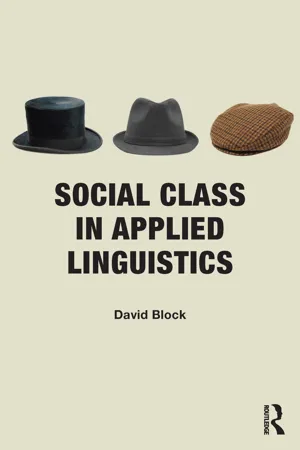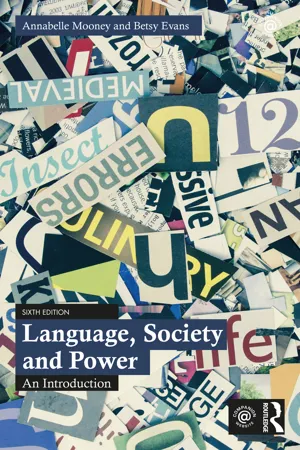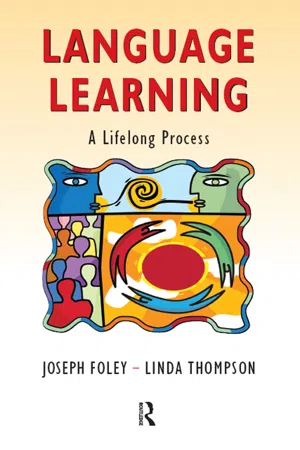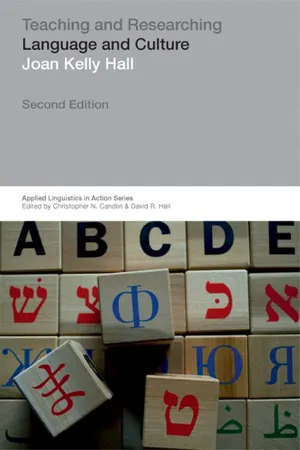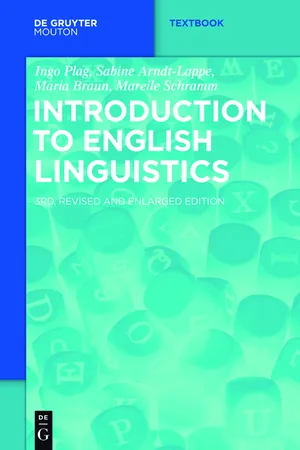Languages & Linguistics
Language and Class
"Language and Class" refers to the relationship between language use and social class. It explores how language can be a marker of social status and how individuals from different social classes may use language differently. This can include variations in vocabulary, accent, and grammar, which can impact how individuals are perceived and their access to opportunities.
Written by Perlego with AI-assistance
Related key terms
8 Key excerpts on "Language and Class"
- eBook - ePub
- David Block(Author)
- 2013(Publication Date)
- Routledge(Publisher)
3 SOCIAL CLASS IN SOCIOLINGUISTICS IntroductionGiven its strong historical links to the social sciences, and sociology especially, sociolinguistics has always been uniquely positioned to incorporate social class as a key construct, far more than other areas of applied linguistics. And many early sociolinguists were drawn to social class as a construct central to understandings of the social life of language use, following dominant trends in sociology in the 1960s, when it was a key construct. Still, as I will argue at the end of this chapter, in recent years there has been something of a shift away from social class in terms of its importance as a construct and in some cases outright erasure. In the sections that follow, I propose to take the reader through some of the key sociolinguistics research that has had social class at its centre, critiquing this work as I proceed. I end with some suggestions about future research. First, however, I would like to clarify what I mean when I make reference to the term ‘sociolinguistics’.In an early sociolinguistics textbook entitled Sociolinguistics: An Introduction, Peter Trudgill describes what he calls ‘sociolinguistics proper’ as follows:This covers studies of language in its social context which (whether they be sociological, anthropological or geographical in emphasis) are mainly concerned with answering questions of interest to linguistics, such as how can we improve our theories about the nature of language, and how and why does language change.(Trudgill, 1974a: 33)Subsequently, Trudgill goes on to discuss the interaction between language and social class, language and ethnic group, language and sex, language and context, language and nation and language and geography, exploring, as he does all of this, ‘the ways in which society acts upon language and, possibly, in which language acts upon society … [and] the number of ways in which language and society are interrelated’ (Trudgill, 1974a: 32). Significantly, ‘language’ always comes first in chapter titles, which is consistent with the linguistics-centric approach to sociolinguistics that is integral to Trudgill’s notion of ‘sociolinguistics proper’. - eBook - ePub
Language, Society and Power
An Introduction
- Annabelle Mooney, Betsy Evans(Authors)
- 2018(Publication Date)
- Routledge(Publisher)
Chapter 9Language, class and symbolic capital9.1 INTRODUCTION 9.2 WHAT IS SOCIAL CLASS? 9.3 ATTITUDES TO CLASS 9.4 LINGUISTIC VARIATION 9.5 INTERSECTION OF SOCIAL CLASS AND OTHER VARIABLES 9.6 SOCIAL NETWORKS 9.7 COMMUNITIES OF PRACTICE 9.8 SYMBOLIC CAPITAL 9.9 REVISING THE BRITISH SOCIAL CLASS MODEL 9.10 SUMMARY9.1 IntroductionIn this chapter, we explore social class and symbolic capital . The reason for considering both together is twofold. First, social class is notoriously difficult to define. Second, in order to fully understand the effects of class and the power it may bring, it’s important to engage with the notion of symbolic capital. Objective definitions of class don’t always explain language variation. We begin by examining attitudes to class before considering research on the correlation between Language and Class. We then consider social networks and communities of practice in order to see that language use and symbolic capital may be rather more local than traditional definitions of class suggest. Finally, we examine a recent model of class that gives symbolic capital a central place.9.2 What is Social Class?Social class has long been associated with how much money a person has. That is, the amount of money a person possesses or can earn may place a person in a particular position in a social class hierarchy. However, this relationship has been complicated by the fact that the possession of money no longer relies on being born into a particular family or pursuing a particular profession. While personal wealth can still be considered one of the factors that contribute to the perception of ‘class’, other factors, such as education, where someone lives and, of course, the language a person speaks play an important role in the perception of social class.Many people think that social class is no longer relevant. However, even in societies presented as lacking social class distinctions, it can still be found. In Denmark, like other Scandinavian countries, there is a strong ideology of egalitarianism. As Ladegård puts it, ‘Denmark … is often presented as a country in which social class distinctions are virtually non-existent’ (1998: 183). To investigate this, Ladegård recorded people using different regional varieties of Danish, as well as ‘Standard Danish’. He then asked informants to listen to the voices and rate their intelligence, education, socio-economic status, reliability, friendliness, sense of humour and so on (1998: 187). Significant differences in evaluation emerged across all categories. Standard Danish scored well across all domains, as did a variety known as High Copenhagen. The difference in evaluation of these two varieties compared to all others, however, across all domains, was significant. Ladegård observes, - eBook - ePub
Language, Society and Power
An Introduction
- Annabelle Mooney, Betsy Evans(Authors)
- 2023(Publication Date)
- Routledge(Publisher)
CHAPTER 9 Language, Class, and Symbolic CapitalDOI: 10.4324/9781003120957-9CONTENTS
9.1 INTRODUCTION9.2 WHAT IS ‘SOCIAL CLASS’?9.3 ATTITUDES TO CLASS9.4 LINGUISTIC VARIATION9.5 INTERSECTION OF SOCIAL CLASS AND OTHER VARIABLES9.6 SOCIAL NETWORKS9.7 COMMUNITIES OF PRACTICE9.8 SYMBOLIC CAPITAL9.9 REVISING THE BRITISH SOCIAL CLASS MODEL9.10 SUMMARY9.1 INTRODUCTION
In this chapter, we explore social class and symbolic capital. The reason for considering both together is twofold. First, social class is notoriously difficult to define. Second, in order to fully understand the effects of class and the power it may bring, it’s important to engage with the notion of symbolic capital. Objective definitions of class don’t always explain language variation. We begin by examining attitudes to class before considering research on the correlation between Language and Class. We then consider social networks and communities of practice in order to see that language use and symbolic capital may be rather more local than traditional definitions of class suggest. Finally, we examine a recent model of class that gives symbolic capital a central place.9.2 WHAT IS ‘SOCIAL CLASS’?
Social class has long been associated with how much money a person has. That is, the amount of money a person possesses or can earn may place a person in a particular position in a social class hierarchy. However, this relationship has been complicated by the fact that the possession of money no longer relies on being born into a particular family or pursuing a particular profession. While personal wealth can still be considered one of the factors that contribute to the perception of ‘class’, other factors, such as education; where someone lives; and, of course, the language a person speaks play important roles in the perception of social class. As Chun notes, social class is not a ‘thing’; rather, it is a ‘social relationship process in performative motion dynamically shaped by situation contexts’ (2019: 333). This means that class is not something a person is; it is something they do. What this looks and sounds like will depend on the situation and the people present. In this chapter we focus on class in Western countries. However, social class, or something like it, operates in most of the world. As Banda notes, ‘Social class signals, that is, lifestyle statuses (e.g. residing in an upmarket neighbourhood and owning expensive SUVs) and behaviours (e.g. standard speech forms) can provide information about an individual’s earnings, career or employment status, and other dimensions of social class’ (2020: 7). - eBook - ePub
The Language of Schooling
A Functional Linguistics Perspective
- Mary J. Schleppegrell(Author)
- 2004(Publication Date)
- Routledge(Publisher)
1A better understanding of the ways language construes academic knowledge is important for students and teachers, linguists and language researchers, textbook writers and administrators. This chapter reviews research that demonstrates the ways language socialization practices prepare some children for the contexts of schooling. It also reviews descriptions of school language use that highlight the linguistic choices that are highly valued in school tasks. It is these choices that can be characterized as the language of schooling. The functional linguistic analysis that follows in later chapters links the language features with the social contexts they realize to show the close relationship between language and context, and to illustrate the challenges for students whose socialization has not prepared them to participate fully in the school context.LIFE EXPERIENCE AND LANGUAGE DEVELOPMENT
Language use in the classroom differs from language use in other social situations in many ways. It involves the sharing of ideas and knowledge rather than the sharing of personal relationships and accomplishment of activities together in familiar contexts. Power relationships, expectations for participation, and the forms that discourse takes also differ at home and school. When they go to school, children engage in new kinds of tasks and need to use language for new purposes. Sociolinguistic research has shown that many children come from homes and communities that do not use language in the ways associated with typical school contexts (e.g., Cazden, John, & Hymes, 1972; Heath, 1983; Philips, 1972; Scollon & Scollon, 1981; Watson-Gegeo & Boggs, 1977; see review of studies in Au & Kawahami, 1994). The study of classroom language and its relationship to the social and cultural contexts of home language has demonstrated that there are major discontinuities for many children between language use in school and community. Children from non-mainstream backgrounds have had different experiences and developed different linguistic resources from those that are typically assumed in the school setting. - eBook - ePub
Language Learning
A Lifelong Process
- Joseph Foley, Linda Thompson(Authors)
- 2017(Publication Date)
- Routledge(Publisher)
Our description of what does it mean to learn language(s) gives equal emphasis to language as a functional resource for getting things done in social contexts with language as a cognitive resource, for thinking and understanding. We emphasize language as a social and as an internalized cognitive resource for building a view of the world. We stress languages as the channel and resource, with which and through which the child learns to create and build taxonomies. In this sense language includes a number of complementary dimensions that can be summarized in the following diagram.Figure 4.4Language metaredounding with register, metaredounding with genre (Christie & Martin 1997: 08)This description of learning language places social contexts as central to learning language. Others, including the sociologist Basil Bernstein (1971 and 1990), have shown that certain types of social context are critical to the process of cultural transmission. The language of these contexts plays a crucial role in the child’s socialization and enculturation into the appropriate social and cultural behaviours of the community where the child is being raised. Halliday’s description, which places all language behaviour mediated through the basic functions of language, is linked to what Malinowski termed ‘context of situation’. These language functions are part of human behaviour. They lie at the heart of the linguistic system and hence can be interpreted as the ‘context of culture’ (to use another of Malinowski’s concepts). The significance of this description is that it explains the way in which language comes to occupy a central role in the process of social and learning, as well as cognition. This may account for the fact that many critics choose to forget when they refer to Halliday’s description of learning a language, and perhaps surprisingly is, the fact that intonation, a complex feature of language use, much neglected by descriptive linguistics, lies at the heart of the Hallidayan description of learning language(s).Central to this description of language development is the concept of the social functions that are achieved with and through language. The original social functions survive in the concrete sense as types of situation and setting, the social contexts in which language serves in the transmission of culture to the child. We can now expand the list of key features unique to a systemic description of learning language presented earlier to include: - eBook - ePub
- Joan Kelly Hall(Author)
- 2013(Publication Date)
- Routledge(Publisher)
Section I Defining language and culturePassage contains an image
This chapter:Chapter 1 A sociocultural perspective on language and culture
DOI: 10.4324/9781315833712-3- describes current perspectives on the nature of language and culture in the field of applied linguistics;
- traces the lineage of some of the more significant assumptions on which current understandings are based;
- offers a list of additional readings on the topics covered in this chapter.
1.1 Introduction
Few would disagree that the study of language use is the central concern of applied linguistics, but opinions differ in how such study is to be conceptualised. Some have argued (see, for example, Pennycook, 2001 , and Widdowson, 2000 ) that, until recently, much of what has taken place in applied linguistics is better understood as ‘linguistics applied’, a subset of the field of linguistics in which knowledge about language is used to address language-related concerns such as language teaching and language policy decisions. From the ‘linguistics applied’ perspective, language is considered to be a set of abstract systems whose meanings reside in the forms themselves rather than in the uses to which they are put. The contexts from which data are taken are considered useful places from which to locate and extract linguistic elements. But, at the same time, they are treated as ancillary to the analysis.Investigations taking a ‘linguistics applied’ approach involve overlaying linguistic forms on instances of language use and interpreting their meanings in light of the structural frameworks. That is, concern is not with the concrete act of using language but rather with the forms themselves as objects of analysis in their own right. As Widdowson (2000 - eBook - ePub
- Miriam Meyerhoff(Author)
- 2018(Publication Date)
- Routledge(Publisher)
These neighbourhood categorisations are used by marketers (they determine what leaflets arrive in your mail) and by teachers, police and other public sector planning groups. They have not yet been widely used in sociolinguistic research, but as social scientists employ greater finesse in identifying social classes we can expect to see benefits flowing on from this to the study of linguistic variation.No, really?
On 25 January 2004, the Observer newspaper in Britain reported a classification system that ranks British households into one of 61 different profiles. Obviously, these get quite detailed and cover only small segments of the population, which then get combined to form larger classes. What is known in Britain as ‘the chattering class(es)’ – that is, people with metropolitan values, attitudes and spending patterns – break down into more specific categories. (Do you feel like you are, or aspire to be, one of these? What do you think of the labels for the groups the marketers have chosen?)The New Urban Columnist: Well-qualified young professionals working in occupations such as financial services, PR and the media. Open to new fashions in taste and thinking. Drawn to inner-city life as they find it more stimulating than suburbia.The Counter-Cultural: Young and mobile people in their twenties and thirties. Live on their own or in transient relationships. Many associated with the gay scene. Thoughtful, well educated. Tend to live in areas with a diverse mix of people.The University Challenge: Typically a student. Lives in rented accommodation in areas that come to life in the evening. Displays a strong belief in informality and authenticity.Class as a factor in linguistic variationWe have already seen a lot of evidence that variables are subject to quite systematic stratification in the speech of individuals and groups. For instance, we saw stratification according to speaker style (Chapter 3 ), and stratification according to age (Chapter 7 - eBook - ePub
- Ingo Plag, Sabine Arndt-Lappe, Maria Braun, Mareile Schramm(Authors)
- 2015(Publication Date)
- De Gruyter Mouton(Publisher)
7 Extensions and applications: historical linguistics, sociolinguistics and psycholinguistics
7.1 Introduction
In the preceding chapters you have encountered a host of language phenomena from various domains (phonetics, phonology, morphology, syntax, semantics, pragmatics), and you have learned how these phenomena can be investigated in order to find out more about the structure and use of language. Apart from these areas of linguistic research, scholars (and laypersons) are interested in many more questions concerning language and languages. In this chapter we will deal with three of such sets of questions. First, there are historical questions. How do languages develop and where do individual languages come from? What is the historical relationship between languages, e.g. between English and German? Why and how do languages change? Another set of questions concerns the social significance of language. Why is it that after listening to only a few words a speaker has uttered, we seem to know a lot about this speaker’s social background, for example her education, her social status, in which region she probably grew up, etc.? What exactly is it that is so telling? Third, many people are curious about how humans store and process language, and what language can reveal about our cognitive capacities in general.We will deal with each set of questions in turn, looking at important studies in these fields in an exemplary fashion. As you will notice, trying to meaningfully answer such questions necessitates a general understanding about how language ‘works’, i.e. what kinds of structural entities language consists of and how these entities interact with each other to create that highly complex system we call language. Having worked through the preceding chapters, you are now equipped with this kind of understanding.
Learn about this page
Index pages curate the most relevant extracts from our library of academic textbooks. They’ve been created using an in-house natural language model (NLM), each adding context and meaning to key research topics.
